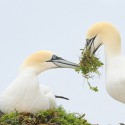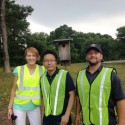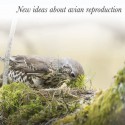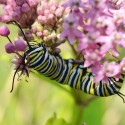 Photo ©
Keith Williams
Photo ©
Keith Williams

Home Tweet Home Winners
On August 3, NestWatch announced the winners of the Home Tweet Home photo contest which ran throughout July. With a total of 540 submissions, voters and judges certainly had their work cut out for them! And the winners are…
- Cutest Baby (Category Winner/People’s Choice): Tricolored Heron by Mike Smeets
- Best Nest (Category Winner/Judges’ Choice): Northern Gannet by Mike Anderson
- Beautiful Eggs (Category Winner): Black Vulture Egg by Steve Stell
- Feeding Time (Category Winner): American Avocet family by Patrick and Arrow Myers
Judges also selected 18 Honorable Mentions that stood out as exceptional submissions. See the gallery of honorees online. We thank everyone who submitted their best work, as well as those who took time to vote for photos.

NestWatch at Work
A growing number of employers consider nest boxes, and nest monitoring, to be a fun way to attract nesting birds to their business campus, document successful stewardship, and give employees meaningful ways to contribute to corporate environmental responsibility in their communities. This month, we’re highlighting two very different companies that are NestWatching, and sharing some tips for starting your own corporate stewardship program.
Sally Cannon is a processing/training coordinator for Bacardi Bottling Corporation, but she is also the Green Champion for the Jacksonville, Florida, campus. As part of Bacardi’s commitment to building a sustainable future, Sally and her colleagues started a bluebird trail in May 2014 and have since been contributing data to NestWatch. She and others have also recently begun planting milkweed to aid in the restoration of monarch butterflies (see sidebar for more on helping monarchs). This Jacksonville facility, with its 22 acres of native grasses and wildflowers, is a “Wildlife at Work” habitat certified by the Wildlife Habitat Council.
Sharon Moore, a legal assistant for Bob Evans Farms, LLC, started up a bluebird trail at the company’s “Farm North” corporate headquarters in New Albany, Ohio, in March 2014. Sharon, an avid birder, got the idea when she spotted a pair of bluebirds while walking the farm trails one day. Two years later, she can proudly say that 66 fledglings have taken wing from the boxes on this “green” commercial property. Sharon checks the boxes every week and reports to NestWatch.
Is your corporation interested in improving its value to wildlife? Here are some ideas to consider:
- Landscape with native plants
- Erect nest boxes
- Install water-friendly features like rain barrels, rain gardens, bioswales, or even a green roof
- Plant for pollinators (many of which are prey for birds)
The best way to document your successes, while also contributing to valuable research, is to participate in citizen science with us. Try recording nests with NestWatch or planning a company-wide Great Backyard Bird Count. We’re all busy, but what better way to spend a lunch break than by checking on the birds once a week?

A New Chapter in Avian Studies
The new avian biology textbook Nests, Eggs, & Incubation: New ideas about avian reproduction, published by Oxford University Press, includes a chapter from NestWatch project leader Robyn Bailey, co-authored with two other leading experts in the field, Caren Cooper (North Carolina Museum of Natural Sciences) and Dave Leech (The British Trust for Ornithology).
This chapter highlights the historic role that citizen science—including nest record schemes like NestWatch—has played in shaping this field. Citizen scientists have contributed to our understanding of:
- Reproductive biology and natural history
- Patterns in brood parasitism
- Timing of nest cycles
- Complex patterns in clutch size
- Breeding distribution and habitat selection
The chapter also identifies future priorities which are uniquely suited for study using citizen-science methodologies, such as population modeling across the entire range of a species, as well as detection of rare phenomena. NestWatchers can be proud that their decades of contributions have been brought to light in this new ornithology text.

Help Maintain Bird & Monarch Habitat
You might have noticed that our Citizen Science Blog has been on a short summer “vacation,” but we’re back with another helpful post for you! This time our newest staff member, Chelsea Benson, writes about how to manage grassland habitat for both birds and the declining monarch butterfly.
Open meadow and grassland habitat is home to an important ecological community. Many kinds of birds nest in grasslands, from bluebirds to goldfinches. So, how do you know when it’s safe to mow, especially if you’re trying to help other wildlife, like monarchs? Read the article to find out.
This article refers to those grassy areas you may have set aside for wildlife, which has grown tall enough for critters to inhabit (as opposed to manicured lawns). If you don’t have such an area yet, consider carving out a chunk of lawn and converting it. Even a small patch is helpful for birds and pollinators.